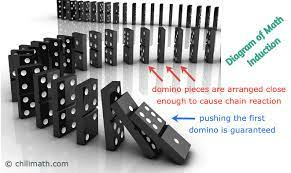Mathematical Induction Techniques

1. Proof by Induction:
Proof by induction is a method used to prove that a statement holds true for all natural numbers (or a specific subset of natural numbers). It involves two steps: the base case and the inductive step.
Base Case:
The base case is the initial step where we prove that the statement is true for the first natural number, typically n = 1 or n = 0.
Inductive Step:
The inductive step involves two parts: the inductive hypothesis and the inductive proof.
Inductive Hypothesis:
We assume that the statement is true for some arbitrary value k, known as the "inductive hypothesis."
Inductive Proof:
We then prove that if the statement holds true for k, it must also hold true for k+1. This is done by using the inductive hypothesis to establish the truth of the statement for k+1.
Example: Proof of the sum of the first n natural numbers.
Statement: 1 + 2 + 3 + ... + n = n(n+1)/2
Base Case: For n = 1, 1 = 1(1+1)/2 is true.
Inductive Hypothesis: Assume the statement is true for some arbitrary k.
Inductive Proof:
We need to prove that if the statement is true for k, it must be true for k+1.
Assuming 1 + 2 + 3 + ... + k = k(k+1)/2, we add (k+1) to both sides:
1 + 2 + 3 + ... + k + (k+1) = k(k+1)/2 + (k+1)
(k+1)(k+2)/2 = (k2 + k + 2k + 2)/2
(k+1)(k+2)/2 = (k2 + 3k + 2)/2
(k+1)(k+2)/2 = (k+1)(k+2)/2
This completes the proof by induction.
2. Proof by Strong Induction:
Proof by strong induction is similar to proof by induction, but it assumes the truth of the statement for all values up to k in the inductive step, rather than just assuming it for k.
Example: Proof of the Division Algorithm:
Statement: For any positive integers a and b, there exist unique integers q and r such that a = bq + r, where 0 ≤ r < b.
The base case, inductive hypothesis, and inductive proof are similar to proof by induction.
3. Proof by Smallest Counterexample:
Proof by smallest counterexample involves assuming that a statement is false and then finding the smallest counterexample, which is the smallest value for which the statement fails. By showing that the statement holds true for all values smaller than the counterexample, we establish its truth for all values.
Example: Proof by Smallest Counterexample for "Every positive integer can be expressed as a sum of distinct powers of 2."
Assume the statement is false and consider the smallest counterexample. By showing that the statement holds true for all positive integers smaller than the counterexample, we reach a contradiction.
4. The Fundamental Theorem of Arithmetic:
The Fundamental Theorem of Arithmetic states that every positive integer greater than 1 can be uniquely factored into prime numbers, disregarding the order of the factors.
Example: Prime factorization of 24:
24 = 2 × 2 × 2 × 3 = 23 × 3
5. Fibonacci Number Proof by Induction:
The Fibonacci sequence is defined recursively, with the first two terms as 0 and 1, and subsequent terms obtained by adding the previous two terms. Proof by induction can be used to establish properties of the Fibonacci sequence.
Example: Proof that every third Fibonacci number is even.
Base Case: For n = 0, the first Fibonacci number is 0, which is even.
Inductive Hypothesis: Assume the statement is true for some arbitrary k.
Inductive Proof:
We need to prove that if the statement is true for k, it must be true for k+1.
Assuming the kth Fibonacci number is even, we can express it as Fk = 2m for some integer m.
The (k+1)th Fibonacci number is Fk+1= Fk + Fk-1.
Substituting the assumption, Fk+1= 2m + Fk-1.
Since Fk-1 is also even (based on the assumption), the sum of two even numbers is always even. Therefore, the (k+1)th Fibonacci number is even.
This completes the proof by induction.
In summary, proof by induction, strong induction, proof by smallest counterexample, and proof of mathematical statements involving specific properties (such as the Fundamental Theorem of Arithmetic and Fibonacci numbers) are common techniques used in mathematical reasoning to establish the truth of statements and properties.